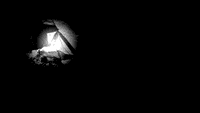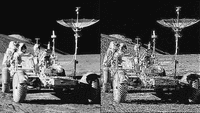Examples+
Blur
A low-pass filter blurs an image. This program analyzes every pixel in an image and blends it with the neighboring pixels to blur the image.
/**
* Blur.
*
* This program analyzes every pixel in an image and blends it with the
* neighboring pixels to blur the image.
*
* This is an example of an "image convolution" using a kernel (small matrix)
* to analyze and transform a pixel based on the values of its neighbors.
*
* Image blur is also called a "low-pass filter". Pixels of low frequency
* change (similar brightness as neighbors) are left mostly unchanged, while
* those with high frequency change (sharply different values) are smoothed
* out.
*
* The kernel here is a Box Blur, in which all components are equally valued.
* Another common blur is "Gaussian Blur", in which pixels nearer the center
* of the kernel have more weight than those further away.
*
* An example 3x3 Gaussian kernel might be: [ 1 2 1 ]
* 1/16 * [ 2 4 2 ]
* [ 1 2 1 ]
*
* An example 5x5 kernel, which creates a greater blur effect:
* [ 1 4 6 4 1 ]
* [ 4 16 24 16 4 ]
* 1/256 * [ 6 24 36 24 6 ]
* [ 4 16 24 16 4 ]
* [ 1 4 6 4 1 ]
*/
float v = 1.0 / 9.0;
float[][] kernel = {{ v, v, v },
{ v, v, v },
{ v, v, v }};
PImage img;
void setup() {
size(640, 360);
img = loadImage("moon.jpg"); // Load the original image
noLoop();
}
void draw() {
image(img, 0, 0); // Displays the image from point (0,0)
img.loadPixels();
// Create an opaque image of the same size as the original
PImage blurImg = createImage(img.width, img.height, RGB);
// Loop through every pixel in the image
for (int y = 1; y < img.height-1; y++) { // Skip top and bottom edges
for (int x = 1; x < img.width-1; x++) { // Skip left and right edges
float sumRed = 0; // Kernel sums for this pixel
float sumGreen = 0;
float sumBlue = 0;
for (int ky = -1; ky <= 1; ky++) {
for (int kx = -1; kx <= 1; kx++) {
// Calculate the adjacent pixel for this kernel point
int pos = (y + ky)*img.width + (x + kx);
// Process each channel separately, Red first.
float valRed = red(img.pixels[pos]);
// Multiply adjacent pixels based on the kernel values
sumRed += kernel[ky+1][kx+1] * valRed;
// Green
float valGreen = green(img.pixels[pos]);
sumGreen += kernel[ky+1][kx+1] * valGreen;
// Blue
float valBlue = blue(img.pixels[pos]);
sumBlue += kernel[ky+1][kx+1] * valBlue;
}
}
// For this pixel in the new image, set the output value
// based on the sum from the kernel
blurImg.pixels[y*blurImg.width + x] = color(sumRed, sumGreen, sumBlue);
}
}
// State that there are changes to blurImg.pixels[]
blurImg.updatePixels();
image(blurImg, width/2, 0); // Draw the new image
}
Related Examples
This example is for Processing 4+. If you have a previous version, use the examples included with your software. If you see any errors or have suggestions, please let us know.




